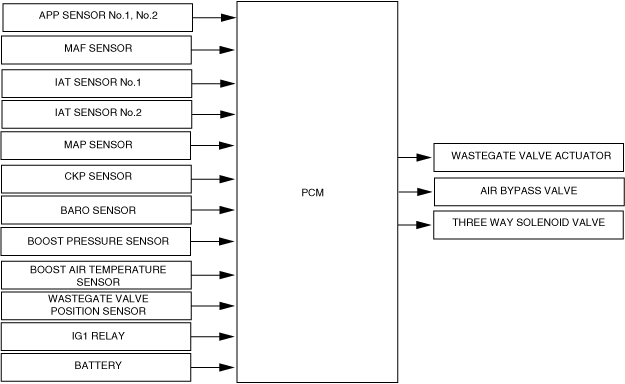BOOST CONTROL [SKYACTIV-G 2.5T]
id0140h0988600
Outline
• The PCM controls the boost pressure to improve the responsiveness of the turbocharger, the acceleration performance and fuel economy of the vehicle, and to reduce surge noise.
• The PCM controls the following 3 valves to obtain optimum boost pressure according to the driving conditions.
-
― Wastegate valve
― Air bypass valve
― Three way solenoid valve
Block Diagram
Operation
• The PCM controls each of the following valves to obtain optimum boost pressure according to the engine operation conditions.
Wastegate valve control
-
• The PCM calculates the opening angle of the wastegate valve to realize the target boost pressure according to the engine operation conditions (output torque).
• The PCM performs feedback control of the wastegate valve to achieve the target boost pressure.
Target boost pressure
-
― The target boost pressure is calculated based on the engine speed and the charging efficiency*1.
Actual boost pressure
-
― Directly detected by the boost pressure sensor.
*1 :Charging efficiency is the ratio of the actual amount of intake air to the maximum air charging amount (mass volume) of the cylinder. The value increases as the engine load increases.
-
• When the PCM determines that the actual boost pressure is high (excessive amount of exhaust gas) against the target boost pressure, it increases the wastegate valve opening angle. In addition, when the PCM determines that the exhaust gas flow during idling is high or when the selector lever is in the N or P position, it opens the wastegate valve.
• When the PCM determines that the actual boost pressure is low (amount of exhaust gas is less) against the target boost pressure, it decreases the wastegate valve opening angle to increase the amount of exhaust gas flowing to the turbine wheel. In addition when the PCM determines that the amount of exhaust gas is low during idling, or when the selector lever is in the D or R position, it closes the wastegate valve.
Air bypass valve control
-
• The PCM switches the energization to the air bypass valve according to the engine operation conditions.
• The PCM fully opens the air bypass valve to protect the parts during overboost.
|
Energization to air bypass valve
|
Implementation conditions
|
Air bypass valve operation conditions
|
|
ON
|
When any of the following conditions is met
• Vehicle speed decelerates based on driver's request
• Overboost determined
|
Fully open
|
|
OFF
|
Conditions other than above
|
Fully closed
|
Three way solenoid valve control
-
• The PCM switches the energization to the three way solenoid valve according to the engine operation conditions.
• The three way solenoid valve controls the opening/closing of the exhaust manifold variable valve to increase the turbocharger turbine operation force.
|
Energization to three way solenoid valve
|
Implementation conditions
|
Exhaust manifold variable valve operation conditions
|
|
ON
|
Conditions other than above
|
Fully closed
|
|
ONFF
|
When any of the following conditions is met
• Engine speed is 1,620 rpm or more
• Excessive amount of exhaust gas during idling
|
Fully open
|
